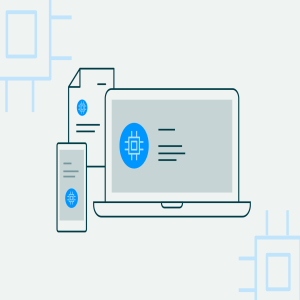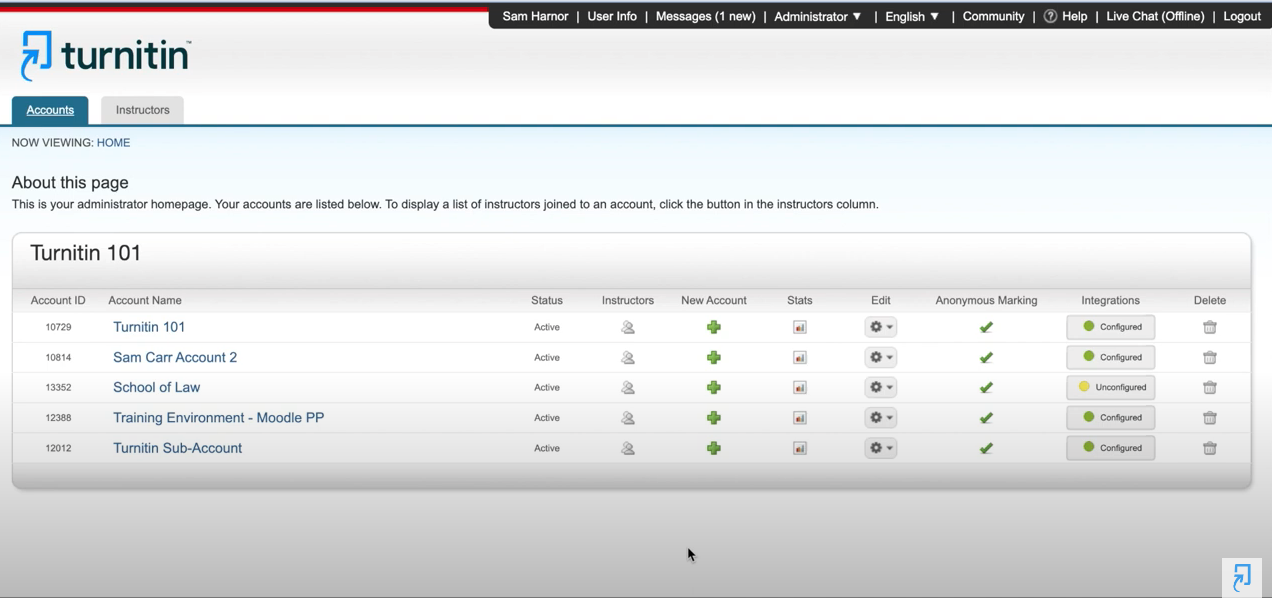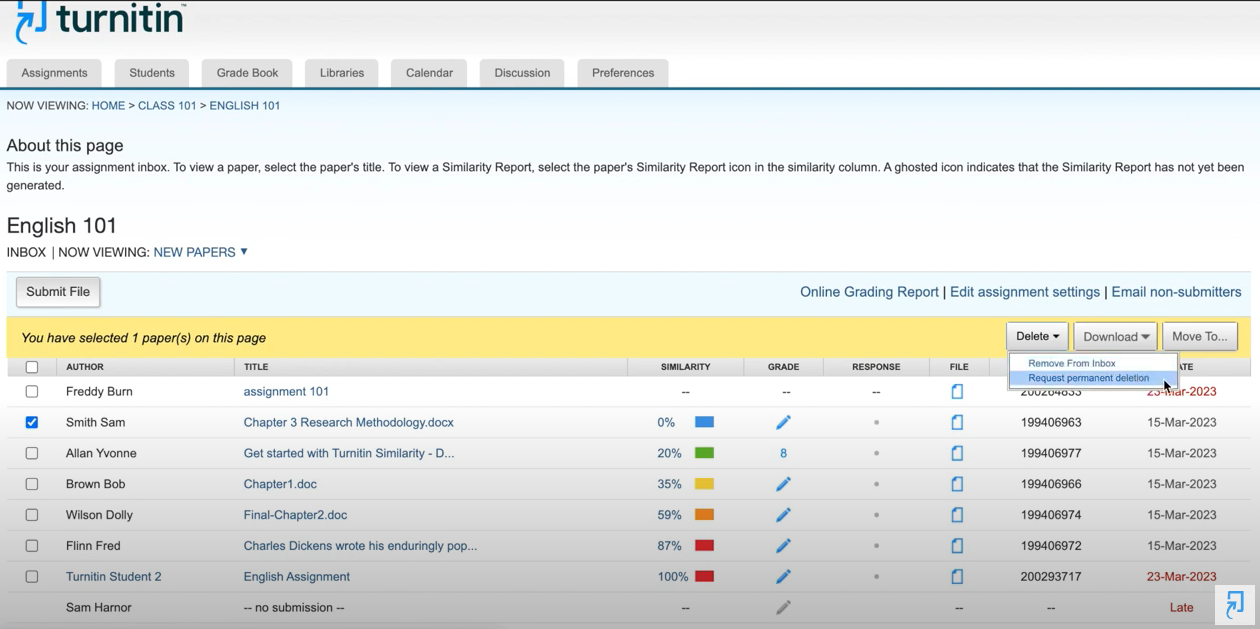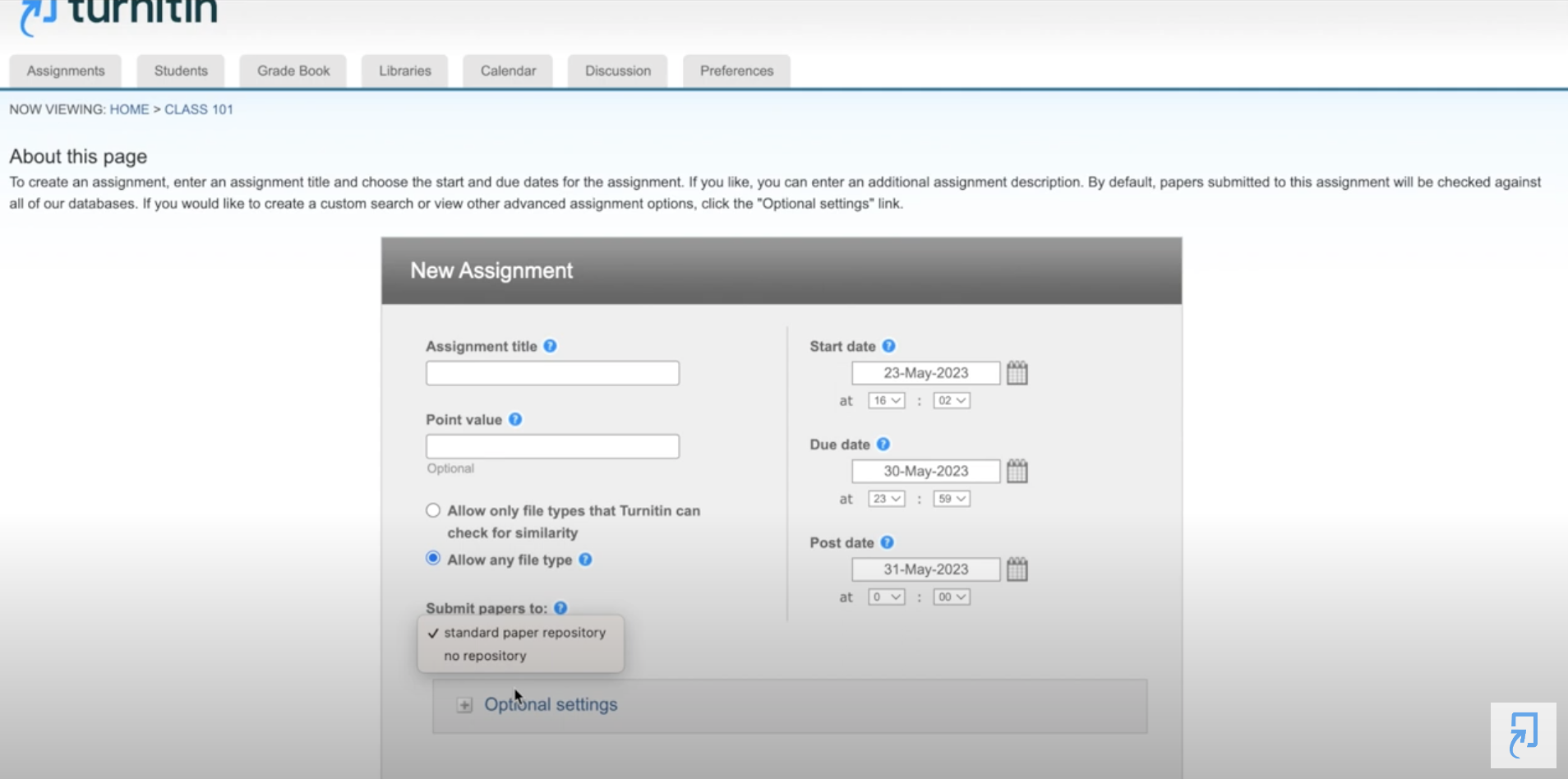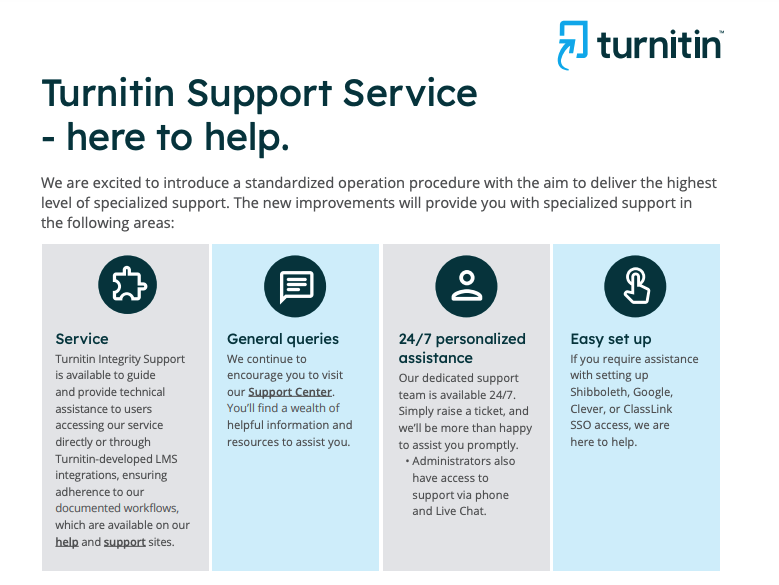Turnitin Support is here to facilitate student learning by offering crucial assistance to students, educators, and administrators. Think of us as that teammate who is always available.
At the beginning of my teaching career, I was often told to make the acquaintance of key people in the building–and they weren’t referring to principals or department heads. Vital to running the school building are the support staff, those who know where the secret stash of bulletin board supplies are kept, or how to reboot the router so everyone has access to the internet, or clean up after us, or feed us. Little is more frustrating than being ready to begin a lesson and something isn’t working as expected.
Knowing where to go for answers in varying situations is of the utmost importance. With that in mind, Turnitin Support offers a variety of resources to help administrators (we are referring to Turnitin account administrators in this context), instructors, and students use our tools more efficiently and effectively.
While the first blog in our series focused on pedagogy and resources, this second one aims to outfit everyone with the technical support that may be needed to implement lessons in the classroom–and to do so efficiently and well.
Why do educators reach out for Turnitin Support at the start of the academic year?To give a bit of background, Arne Smits, Director of Technical Support, says that Turnitin typically receives three categories of requests for support: queries (“How-to's"), tasks (“Can you please…” ) and issue reports (“It does not work…”).
Three questions that top the list within those categories are listed below–with solutions already outlined to give everyone a head start at the beginning of the academic year–just in case one of these topics presents a challenge.
How do I delete a paper on Turnitin? How do I restore a paper?Paper deletions are a frequent faculty request for a multitude of reasons. In order to streamline the paper deletion workflow, Turnitin has added paper deletion functionality to the product so that Administrators can carry this out themselves, without having to raise a request with Turnitin Support.
The videos below are helpful in explaining the Turnitin Repository, its usage, and how to go about deleting a paper.
Defining the Turnitin repository and how to delete a paper (for administrators)This video will demonstrate how administrators can manage paper deletions more effectively through their Turnitin account. Other resources are available as well.
This video will demonstrate how instructors can manage paper deletions more effectively through their Turnitin account. Other resources are available as well.
This video will demonstrate how both administrators and instructors can manage paper deletions more effectively through their Turnitin account. Other resources are available as well.
Account access comes in second on the list of most common support or help requests. Knowing that, the Turnitin Support team has created web pages and links available 24/7 without having to wait for a reply.
Need a password reset? No problem!
- If you’re located in the UK, click here for a password reset.
- If you’re located anywhere else in the world, click here for a password reset.
- If Turnitin is accessed by a Learning Management System (LMS) like Moodle, Blackboard, Canvas, etc., contact the instructor for the course or other support system the institution has in place.
Clearly, these few links don’t address all the variations and nuances of this topic so Help documents are readily available to address many more specific concerns.
How do I view/interpret the Similarity Report?The insights provided to educators and students by the Similarity Report is vitally important for effective usage so a clear understanding is essential. Because of its importance, much has been written on this critical educational tool. Searching Turnitin’s help pages for “Similarity report” returned 1,325 results, however, so here are a few guiding suggestions for common queries:
- If viewing the Similarity Report is the issue, students can follow these directions from the Help guides.
- If understanding the Similarity Report is the issue, students can access this resource on how to interpret the Similarity Report. Students might also seek information from a video differentiating between similarity and plagiarism.
- If understanding the Similarity Report is an issue for educators, a similar document on how to interpret the Similarity Report for educators is also available. This document is part of the Disrupting Plagiarism instructional resources, where other resources exist, such as Setting Reasonable Expectations for the Similarity Score to help educators understand the relationship between this score and student writing.
- If educators are seeking more information on how to understand how plagiarism and similarity are alike, yet not identical, or how to further understand what difference this makes in the classroom, accessing Turnitin blogs provides an excellent pool of resources too.
While the first part of this blog addressed the top issues Turnitin Support typically receives, this next section points educators to the support options that are readily available, no matter what the issue may be.
Download this helpful infographic on Turnitin Support Services and save it to a computer desktop or print it so assistance is available as it is needed.
Help is available 24-7 for self-service assistance – and no wait time!Going to the help page provides answers on a variety of topics related to using our products and services.
- First, choose the product from the list; all are categorized according to the main purpose for usage.
- Next, choose the role: administrator, instructor, or student. Other options are available for some products, such as investigator or release notes.
- Finally, choose the topic that is relevant to the issue being experienced.
Help comes in the form of Q&A (questions and answers), articles, videos, one pagers, to name only a few.
What happens if the problem that requires going to the Help page doesn’t have the answer, or if the issue is too difficult to manage on your own? At the bottom of most pages is a link to Turnitin Support to help educators and students find the answers needed to move forward. Clicking on the “Get in touch” button will allow individuals to raise a support ticket.
The Support Center offers multiple options for information about Turnitin products and offers step by step guidance for some common questions.The first encounter with this webpage are the options for administrators, instructors, or students who are “Getting started.”
Directly below the Getting started guidance are links to User guides and Knowledge Articles. Links to blogs which may be helpful to users may also be linked here. User guides and Knowledge articles may also be accessed via links in the top right corner of the browser window. Filters for user type, access route, and product type can be applied to help narrow the focus more quickly.
If the answer isn’t readily found by searching either of these areas, scrolling to the bottom of the webpage will allow users to “Raise a case request.” You’ll be asked to fill out a brief online form (only 8 items), and our underlying AI will personalize the articles according to your product and user type. As you add more information, such as the “access route,” the AI will again customize the responses. If none of these articles address or fix the issue, providing contact information will ensure that a response can be communicated more efficiently back to the user making the request.
Administrators also have access to support via telephone and Live Chat when logged into the Support Center.
Turnitin Educator Network (TEN) offers a forum to meet other educators to discuss and share best practices using Turnitin.Given how long Turnitin has been in the world of academic integrity, it’s highly likely that the issue you are wrestling with is something that other educators, including our loyal long-time advocates, have also encountered. The Turnitin Educator Network (TEN) is a vibrant global peer support community of Turnitin users, a place to share good practices, to share and receive hints and tips, and to discuss common challenges with like-minded educators all around the world. Whether questions are about AI writing, migrations, integrations, or general approaches to promoting academic integrity, TEN may be just the place! And some folks find that they can help out a colleague at the same time.
Partnering with Turnitin Support to facilitate student learningBy leveraging Turnitin Support resources, teachers are able to create an environment that nurtures academic growth, promotes critical thinking, and empowers students to become independent learners. The insights gained from Turnitin's tools facilitate targeted instruction and personalized feedback, enabling educators to use our tools effectively and meaningfully.
Even in an increasingly technology-heavy world, gaining support is still a matter of knowing where to go for the answers. There will always be complex scenarios that require connecting with a person; however, the resources linked here will empower educators with the tools they need to support students in their academic journey in instant, accessible, and engaging modes. And when instructors have the tools they need to do their best work, so in turn will their students.
Bookmark each of the links below so they’re readily available as needed. And check out the first blog in this series when looking for ways to embed AI writing tools into your toolkit.
In essence, partnering AI writing tools with Turnitin Support opens doors to a world of possibilities, where student learning is enhanced, and teacher workflows become more efficient and powerful. By embracing this collaboration between pedagogy and product, educators can ultimately empower students to succeed in their educational journeys.






